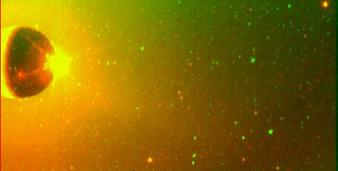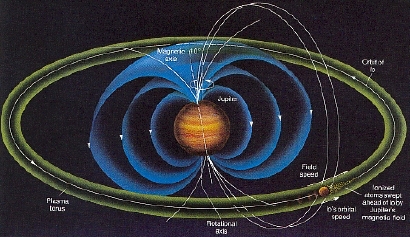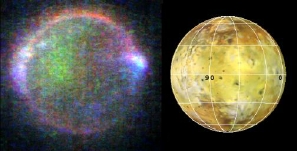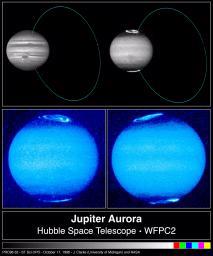Io's Atmosphere
and the
Io Plasma Torus
In spite of the large quantities of gas ejected by its many volcanoes, Io does not have a significant atmosphere. Io's average surface temperature is so low, (about 100 to 110 K (-280 to -290 degrees Fahrenheit), that much of the released gas condenses back onto the surface as frost deposits. The thin atmosphere that does exist is composed primarily of sulfur dioxide gas.
 Some
molecules of gas do escape, however, and Io is surrounded by
a cloud of sodium, potassium, and oxygen atoms. The sodium
cloud, visible in this image, is the most easily observed.
The source of the sodium remains a mystery to scientists
because it has not yet been detected anywhere on Io's
surface. Recently, the element chlorine was also discovered.
This finding leads scientists to believe that sodium
chloride, or common table salt, may exist on Io and
influence its violent volcanic activity. Prior to this
discovery, only sulfur, oxygen, sodium, and potassium atoms
were observed escaping Io's atmosphere.
Some
molecules of gas do escape, however, and Io is surrounded by
a cloud of sodium, potassium, and oxygen atoms. The sodium
cloud, visible in this image, is the most easily observed.
The source of the sodium remains a mystery to scientists
because it has not yet been detected anywhere on Io's
surface. Recently, the element chlorine was also discovered.
This finding leads scientists to believe that sodium
chloride, or common table salt, may exist on Io and
influence its violent volcanic activity. Prior to this
discovery, only sulfur, oxygen, sodium, and potassium atoms
were observed escaping Io's atmosphere.
Two common compounds of chlorine are sodium chloride, table salt, and hydrogen chloride, which is a colorless gas emitted by volcanoes. Scientists do not yet know if the chlorine is emitted from Io's volcanoes, or comes from the breakup salt on Io's surface by charged particles in the plasma torus. How salt might form on Io is unclear. It may be that there are subsurface rivers or aquifers supplying the fuel for Io's volcanoes that carry dissolved salts, or the salts may be the result of chemical reactions in the atmosphere.

Within Jupiter's magnetosphere, there is a significant amount of hot, ionized gas, or plasma. This plasma moves along with Jupiter's rotating magnetic field, sweeping charged particles off the surfaces of its moons as it passes them. Io has a particularly significant impact on Jupiter's magnetosphere. Io's volcanoes continually expel an enormous amount of particles into space, and these are swept up by Jupiter's magnetic field at a rate of 1,000 kg/sec. This material becomes ionized in the magnetic field and forms a doughnut-shaped track around Io's orbit called the Io Plasma Torus.
 This
image of Io was taken while the moon was in Jupiter's
shadow. The vivid colors are the result of collisions
between Io's atmospheric gases and charged particles trapped
in Jupiter's magnetic field. The red and green colors are
probably produced by mechanisms similar to those that
produce the aurora in Earth's polar regions. The blue light
indicates locations where dense plumes of volcanic vapor
rise into space. These may be places where Io is
electrically connected to Jupiter.
This
image of Io was taken while the moon was in Jupiter's
shadow. The vivid colors are the result of collisions
between Io's atmospheric gases and charged particles trapped
in Jupiter's magnetic field. The red and green colors are
probably produced by mechanisms similar to those that
produce the aurora in Earth's polar regions. The blue light
indicates locations where dense plumes of volcanic vapor
rise into space. These may be places where Io is
electrically connected to Jupiter.
 As
Io circles around Jupiter and through the plasma torus, an
enormous electrical current flows between them.
Approximately 2 trillion watts of power is generated. The
current follows the magnetic field lines to Jupiter's
surface where it creates lightning in the upper atmosphere.
The first black and white Hubble Space Telescope image (top)
shows the flux tube, where Io and Jupiter are linked by an
electrical current of charged particles. Volcanic emissions
from Io flow along Jupiter's magnetic field lines, through
Io, to Jupiter's north and south magnetic poles. In the
second black and white image, auroral emissions are visible
at Jupiter's north and south poles. The ultraviolet image
below shows how the structure and appearance of Jupiter's
aurora changes at it rotates.
As
Io circles around Jupiter and through the plasma torus, an
enormous electrical current flows between them.
Approximately 2 trillion watts of power is generated. The
current follows the magnetic field lines to Jupiter's
surface where it creates lightning in the upper atmosphere.
The first black and white Hubble Space Telescope image (top)
shows the flux tube, where Io and Jupiter are linked by an
electrical current of charged particles. Volcanic emissions
from Io flow along Jupiter's magnetic field lines, through
Io, to Jupiter's north and south magnetic poles. In the
second black and white image, auroral emissions are visible
at Jupiter's north and south poles. The ultraviolet image
below shows how the structure and appearance of Jupiter's
aurora changes at it rotates.
Photo Credits: NASA/JPL
Illustration Credit: NASA
